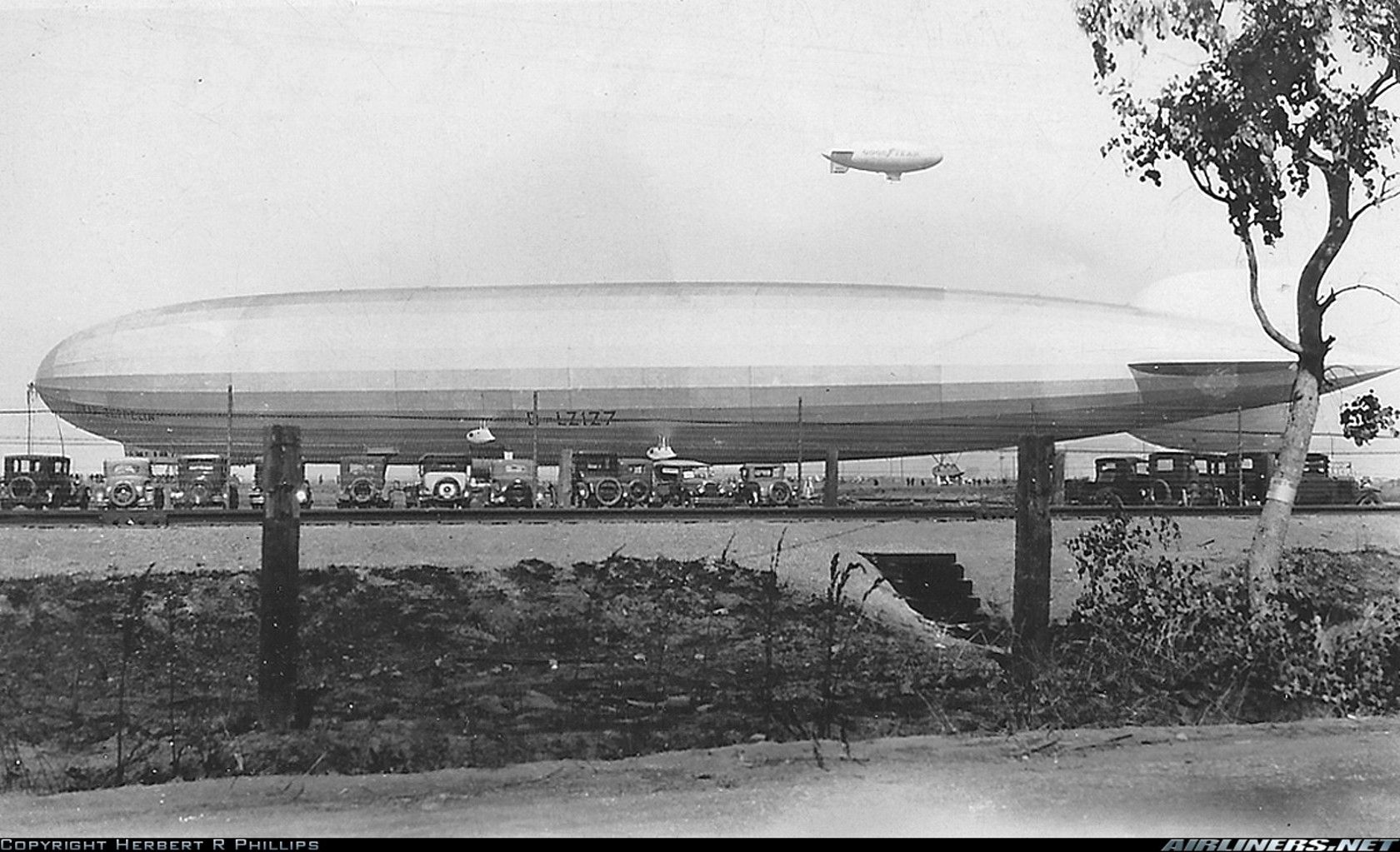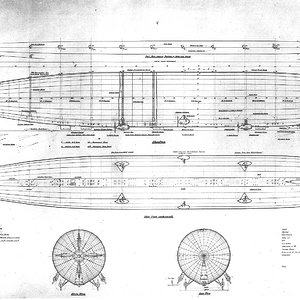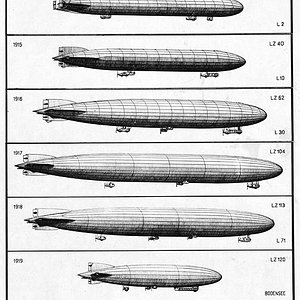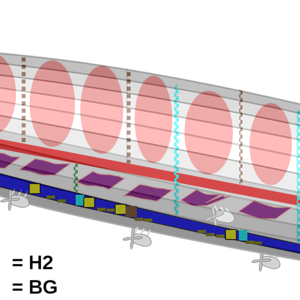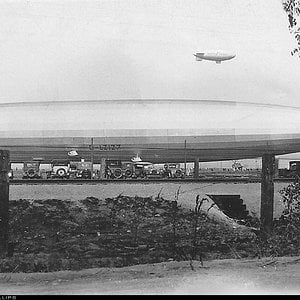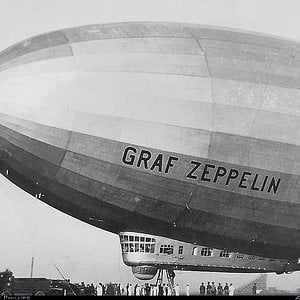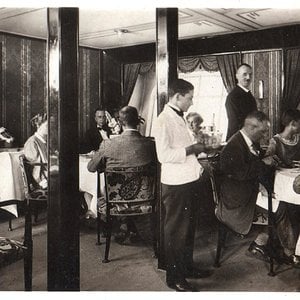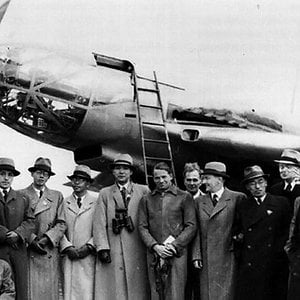Navigation
Install the app
How to install the app on iOS
Follow along with the video below to see how to install our site as a web app on your home screen.
Note: This feature may not be available in some browsers.
More options
You are using an out of date browser. It may not display this or other websites correctly.
You should upgrade or use an alternative browser.
You should upgrade or use an alternative browser.
Design and development
Construction of the Graf Zeppelin in Friedrichshafen: the lower and middle gangways are highlighted green with main rings in red; two people are shown in yellow.
Built at the Zeppelin Company works (Luftschiffbau Zeppelin) in Friedrichshafen am Bodensee, Germany, between 1926 and 1928, the design of the LZ-127 was patterned on that of the LZ-126 which the company had delivered as a war reparation to the U.S. Navy at NAS Lakehurst, NJ in October 1924 where it was commissioned as the USS Los Angeles (ZR-3).[1] With that project completed, the Zeppelin company's chairman Dr. Hugo Eckener promptly began a two year campaign of lobbying the German Government for funds and permission to proceed with construction of a new airship for Germany.[2] Construction began in 1926 with the aid of a government grant although the majority of the necessary 2,000,000 Reichsmarks (RM) in funding would eventually be raised by public subscription.[3] The LZ 127 was completed and launched in September 1928.
At 236.6 m (776 ft) and a total gas volume of 105,000 m³ (3,707,550 ft³) of which 75,000 m³ (2,648,585 ft³) was hydrogen carried in 17 "lift gas" cells (Traggaszelle) and 30,000 m³ (1,059,435 ft³) was Blau gas in 12 "power gas" cells (Kraftgaszelle)), the Graf was the largest airship in the world at the time. It was powered by five Maybach VL-2 12-cylinder 550 hp engines that could burn either Blau gas or gasoline.[4]
Although the Graf could achieve a top airspeed of 128 km/h (80 mph, 70 knots) at its maximum thrust of 2,650 horsepower (1,980 kW), its normal operational airspeed was 117 km/h (73 mph, 63 knots) at a thrust of 2,150 horsepower (1,600 kW).[4] Some flights were made using only Blau gas carried in the dozen power gas cells which enabled the airship to cruise for up to 100 hours. Using gasoline alone it was able to cruise for 67 hours, and up to 118 hours using both. The Graf Zeppelin had a total lift capacity of 87,000 kilograms (191,800 lbs) with a usable payload of 15,000 kg (33,000 lbs) on a 10,000 km (6,200 mi) flight.[4]
[edit] Gondola layout
LZ 127 Graf Zeppelin gondola deck plan.
The flight deck and operational spaces, common areas, passenger cabins, and public toilet facilities on the Graf Zeppelin were all contained in a single contiguous "gondola" structure built in to the forward third of the airship's ventral surface. The forward operational spaces consisted of the flight deck, a map/navigation room with two large open access hatches to allow the command crew to communicate with the navigators, radio room, galley, and a short passage to the main entrance-exit door space. An ascending ladder located in the map room allowed access to a keel corridor inside the hull. The map room also had two large windows, one on each side, which permitted navigators to shoot the horizon and sky with a sextant.
Behind the operational spaces were the main dining and sitting room with four large windows which connected via a long corridor to ten passenger cabins capable of sleeping 24, a pair of washrooms, and dual toilet facilities.[5] The passenger cabins were set by day with a sofa which converted to two beds, one above the other, at night.[6] The crew's quarters were located inside the hull and were reached by a catwalk. The galley was equipped with a single electric oven with two compartments and hot plates on top for cooking.[6]
[edit] Electrical and communications systems
Many people were needed to hold down the D-LZ127. The ram air turbine electric generator is just under the radio room window.
The main generating plant was inside the hull and consisted of two fuel-burning generators.[6] Two small ram air turbines attached to the main gondola on swinging arms supplemented electrical power for the radio room, internal lighting, the galley, and acted as a reserve. Batteries stored the electrical energy so that radio operation was independent of airspeed.[7] The gondola also had a gasoline generator for emergency power.
The Graf was outfitted with the most modern radio equipment then available.[7] A staff of three radio operators communicated with ground stations and ships, performed radio navigation,[7] received weather reports, and sent private telegrams for passengers. A one kilowatt vacuum tube transmitter (about 140 watt antenna power) was used to send telegrams over the low frequency (500-3,000 m) bands.[7] A 70 watt antenna power emergency transmitter was available for both telegraph and radio telephone over 300-1,300 m wavelength bands which could be powered by either batteries or the gasoline generator.[7]
The main antenna consisted of two lead weighted 120-meter-long wires deployed by electric motor or hand crank. The emergency antenna was a 40-meter wire stretched from a ring on the airship hull.[7] Three high-quality, six-tube receivers served the wavelength ranges 120 to 1,200 m (medium frequency), 400 to 4,000 m (low frequency) and 3,000 to 25,000 m (overlapping low frequency and very low frequency).[7] The radio room also had a shortwave receiver for wavelengths 10 to 280 m (high frequency).[7]
A radio direction finder of the kind then used by large passenger ships employed a rotatable loop antenna to determine the airship's position from any two land radio stations or ship-based transmitters from ships with known positions.[7] During the airship's transatlantic flight to the United States in October 1928, the radio room sent 484 private telegrams and 160 press telegrams.[7]
Crew: 40
Capacity: 20 passengers
Length: 236.53 m (776 ft 0 in)
Diameter: 30.48 m (100 ft 0 in)
Volume: 105,000 m3 (3,707,550 ft3)
Useful lift: 60,000 kg (132,000 lb)
Powerplant: 5 × Maybach engines, 410 kW (550 hp) each
Performance
Maximum speed: 128 km/h (80 mph)
Construction of the Graf Zeppelin in Friedrichshafen: the lower and middle gangways are highlighted green with main rings in red; two people are shown in yellow.
Built at the Zeppelin Company works (Luftschiffbau Zeppelin) in Friedrichshafen am Bodensee, Germany, between 1926 and 1928, the design of the LZ-127 was patterned on that of the LZ-126 which the company had delivered as a war reparation to the U.S. Navy at NAS Lakehurst, NJ in October 1924 where it was commissioned as the USS Los Angeles (ZR-3).[1] With that project completed, the Zeppelin company's chairman Dr. Hugo Eckener promptly began a two year campaign of lobbying the German Government for funds and permission to proceed with construction of a new airship for Germany.[2] Construction began in 1926 with the aid of a government grant although the majority of the necessary 2,000,000 Reichsmarks (RM) in funding would eventually be raised by public subscription.[3] The LZ 127 was completed and launched in September 1928.
At 236.6 m (776 ft) and a total gas volume of 105,000 m³ (3,707,550 ft³) of which 75,000 m³ (2,648,585 ft³) was hydrogen carried in 17 "lift gas" cells (Traggaszelle) and 30,000 m³ (1,059,435 ft³) was Blau gas in 12 "power gas" cells (Kraftgaszelle)), the Graf was the largest airship in the world at the time. It was powered by five Maybach VL-2 12-cylinder 550 hp engines that could burn either Blau gas or gasoline.[4]
Although the Graf could achieve a top airspeed of 128 km/h (80 mph, 70 knots) at its maximum thrust of 2,650 horsepower (1,980 kW), its normal operational airspeed was 117 km/h (73 mph, 63 knots) at a thrust of 2,150 horsepower (1,600 kW).[4] Some flights were made using only Blau gas carried in the dozen power gas cells which enabled the airship to cruise for up to 100 hours. Using gasoline alone it was able to cruise for 67 hours, and up to 118 hours using both. The Graf Zeppelin had a total lift capacity of 87,000 kilograms (191,800 lbs) with a usable payload of 15,000 kg (33,000 lbs) on a 10,000 km (6,200 mi) flight.[4]
[edit] Gondola layout
LZ 127 Graf Zeppelin gondola deck plan.
The flight deck and operational spaces, common areas, passenger cabins, and public toilet facilities on the Graf Zeppelin were all contained in a single contiguous "gondola" structure built in to the forward third of the airship's ventral surface. The forward operational spaces consisted of the flight deck, a map/navigation room with two large open access hatches to allow the command crew to communicate with the navigators, radio room, galley, and a short passage to the main entrance-exit door space. An ascending ladder located in the map room allowed access to a keel corridor inside the hull. The map room also had two large windows, one on each side, which permitted navigators to shoot the horizon and sky with a sextant.
Behind the operational spaces were the main dining and sitting room with four large windows which connected via a long corridor to ten passenger cabins capable of sleeping 24, a pair of washrooms, and dual toilet facilities.[5] The passenger cabins were set by day with a sofa which converted to two beds, one above the other, at night.[6] The crew's quarters were located inside the hull and were reached by a catwalk. The galley was equipped with a single electric oven with two compartments and hot plates on top for cooking.[6]
[edit] Electrical and communications systems
Many people were needed to hold down the D-LZ127. The ram air turbine electric generator is just under the radio room window.
The main generating plant was inside the hull and consisted of two fuel-burning generators.[6] Two small ram air turbines attached to the main gondola on swinging arms supplemented electrical power for the radio room, internal lighting, the galley, and acted as a reserve. Batteries stored the electrical energy so that radio operation was independent of airspeed.[7] The gondola also had a gasoline generator for emergency power.
The Graf was outfitted with the most modern radio equipment then available.[7] A staff of three radio operators communicated with ground stations and ships, performed radio navigation,[7] received weather reports, and sent private telegrams for passengers. A one kilowatt vacuum tube transmitter (about 140 watt antenna power) was used to send telegrams over the low frequency (500-3,000 m) bands.[7] A 70 watt antenna power emergency transmitter was available for both telegraph and radio telephone over 300-1,300 m wavelength bands which could be powered by either batteries or the gasoline generator.[7]
The main antenna consisted of two lead weighted 120-meter-long wires deployed by electric motor or hand crank. The emergency antenna was a 40-meter wire stretched from a ring on the airship hull.[7] Three high-quality, six-tube receivers served the wavelength ranges 120 to 1,200 m (medium frequency), 400 to 4,000 m (low frequency) and 3,000 to 25,000 m (overlapping low frequency and very low frequency).[7] The radio room also had a shortwave receiver for wavelengths 10 to 280 m (high frequency).[7]
A radio direction finder of the kind then used by large passenger ships employed a rotatable loop antenna to determine the airship's position from any two land radio stations or ship-based transmitters from ships with known positions.[7] During the airship's transatlantic flight to the United States in October 1928, the radio room sent 484 private telegrams and 160 press telegrams.[7]
Crew: 40
Capacity: 20 passengers
Length: 236.53 m (776 ft 0 in)
Diameter: 30.48 m (100 ft 0 in)
Volume: 105,000 m3 (3,707,550 ft3)
Useful lift: 60,000 kg (132,000 lb)
Powerplant: 5 × Maybach engines, 410 kW (550 hp) each
Performance
Maximum speed: 128 km/h (80 mph)

